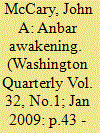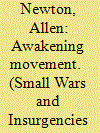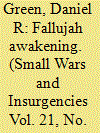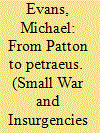|
|
|
Sort Order |
|
|
|
Items / Page
|
|
|
|
|
|
|
| Srl | Item |
| 1 |
ID:
086333


|
|
|
|
|
| Publication |
2009.
|
| Summary/Abstract |
The now-deceased leader of the Anbar Awakening, Sheikh Abd al Sittar Abu Reesha, once said, "Our American friends had not understood us when they came. They were proud, stubborn people and so were we. They worked with the opportunists, now they have turned to the tribes, and this is as it should be."1
Until 2007, the most violent region of insurgent attacks against U.S. forces in Iraq had been al Anbar, the largely rural, expansive western province stretching from the outskirts of Baghdad to Iraq's lengthy, mostly unsecured desert borders with Sunni-dominated Jordan, Saudi Arabia, and Syria.2 In what is most easily described as a marriage of convenience, Sunni insurgents and foreign Sunni al Qaeda fighters in al Anbar had formed a strategic and tactical alliance against what was perceived as an occupation by the United States or, more pointedly, against the occupation of a Muslim land by a largely Christian force, a deep affront to traditional Muslim values harkening back to the Crusades of the Middle Ages.3 Iraqis in al Anbar provided local knowledge, logistics, and up to 95 percent of the personnel, while experienced foreign al Qaeda fighters provided training, expertise, and financing. The pitch was simple: "We are Sunni. You are Sunni. The Americans and Iranians are helping the Shi'a - let's fight them together."
|
|
|
|
|
|
|
|
|
|
|
|
|
|
|
|
| 2 |
ID:
152024


|
|
|
|
|
| Summary/Abstract |
This essay analyzes the link between mobilization and tribalism that developed in the Anbar Awakening. The Anbar Awakening exposed the Anbari tribal structure as a deeply entrenched and complex network deployed to mobilize support and generate behavior that would achieve the most advantageous strategy and position in a fight against al-Qaeda. Although this description supports David Kilcullen’s tribal society model, the rules of the Awakening movement that restored the tribal network were hardly explored by counter-insurgents for value and opportunity. The essay therefore draws on narratives from Anbari sheikhs to analyze the properties of tribalism (culture, identity, and problem-solving) as a non-linear social network, and demonstrates a paradigm in which mobilization of Anbari tribesmen is a valid indicator of security. The link between mobilization and tribalism in the Anbar Awakening therefore strategically develops to intervene in social life and address security locally.
|
|
|
|
|
|
|
|
|
|
|
|
|
|
|
|
| 3 |
ID:
101335


|
|
|
|
|
| Publication |
2010.
|
| Summary/Abstract |
The successful pacification of Fallujah in 2007 during the Anbar Awakening movement was due to the coordinated efforts of US and Iraqi forces to physically and psychologically separate the people from the insurgency. Efforts along security, political, and development lines along with a robust tribal effort eliminated the armed insurgency and set the basis for victory in the area. But a synchronized delivery of these resources was insufficient to defeat the insurgency by itself absent the population's decision to turn against the insurgents. This process began to occur in 2006 and was successfully capitalized upon by Coalition Forces in Fallujah in 2007.
|
|
|
|
|
|
|
|
|
|
|
|
|
|
|
|
| 4 |
ID:
131471


|
|
|
|
|
| Publication |
2014.
|
| Summary/Abstract |
War is the great auditor of military institutions and since the attacks of 9/11, the United States military has been under audit for well over a decade - the longest period of continuous warfare in its entire history - and one in which strategic success seems at best, ambiguous and at worst, elusive. Not surprisingly, the strategic skill and battlefield effectiveness of the American military has been a subject of great inquiry over the last five years. Thomas E. Ricks's mammoth study, The Generals: American Military Command from World War II to Today is but the largest instalment in a plethora of works examining America's military performance in the modern era by such writers as David Cloud and Greg Jaffe, Stephen R. Taaffe, Lewis Sorley, Jean Edward Smith, and Fred Kaplan.1
|
|
|
|
|
|
|
|
|
|
|
|
|
|
|
|
|
|
|
|
|